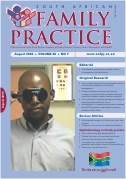The involvement of private general practitioners in visiting primary healthcare clinics
Abstract
Background The primary healthcare system was adopted as the vehicle of healthcare delivery and a means of reaching the larger part of the population in South Africa in 1994. One of the strategies employed in providing a comprehensive service is the incorporation of visits to clinics by doctors in support of other members of the primary healthcare team, particularly nurses. A successful collaboration at this level brings benefit to everyone involved, particularly patients. Clear expectations and a confusion of roles leads to lack of teamwork, thus it is important to have clearly established models for such involvement. Doctors working in district hospitals mostly visit clinics, but their workload, staff shortages and transport often interfere with these visits. As a form of private-public partnership, local GPs are sometimes contracted to visit the clinics. Very little is known about this practice and problems are reported, including the perception that GPs do not spend as much time in the clinics as they are paid for10.Understanding the practice better may provide answers on how to improve the quality of primary care in the district health system. The aim of this study was to describe the experiences of local GPs visiting public clinics regularly over a long period of time. Methods A case study was undertaken in the Odi district of the North West Province in three primary care clinics visited by GPs. The experiences of the doctors, clinic nurses, district managers and patients regarding the GP’s visits were elicited through in-depth interviews. Details of the visits with regard to patient numbers, lengths of the visits, remuneration and preferences were also sought. The data were analysed using different methods to highlight important themes. Results The visits by the GPs to the clinics were viewed as beneficial by the patients and clinic staff. The GPs were often preferred to government doctors because of their skills, patience and availability. The visits were also seen as a gesture of patriotism by the GPs. There were constraints, such as a shortage of medicines and equipment, which reduce the success of these visits. Conclusion The involvement of GPs in primary care clinics is beneficial and desirable. It enhances equity in terms of access to services. Addressing the constraints can optimise the public-private partnership at this level. SA Fam Pract 2006;48(7): 16)
Section
Original Research
By submitting manuscripts to SAFP, authors of original articles are assigning copyright to the South African Academy of Family Physicians. Copyright of review articles are assigned to the Publisher, Medpharm Publications (Pty) Ltd, unless otherwise specified. Authors may use their own work after publication without written permission, provided they acknowledge the original source. Individuals and academic institutions may freely copy and distribute articles published in SAFP for educational and research purposes without obtaining permission.

